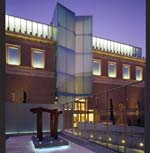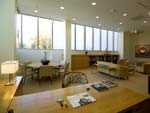
|
|
|
|
 |
|
Home Site Search Contact Us Subscribe
|
|
|
|
Northwest Expansion: The Portland Art Museum by Ann Beha Architects and SERA Architects
Portland, Oregon: Sensitive historic restoration combined with contemporary design expands a museum into a dynamic new art center. by ArchNewsNow August 1, 2006 The Portland Art Museum (PAM) is the oldest – and now largest – museum in the Pacific Northwest. Boston-based Ann Beha Architects (ABA) began its work for PAM in 1994, with the restoration and expansion of the original museum buildings, a series of four modernist structures designed by Pietro Belluschi completed in the 1930s. ABA also drew up a master plan for the museum, and was architect for over $55 million of construction, including the Project for the Millennium – the conversion of the former N.W. College of Art to new galleries and auditorium (2000), and most recently, the Masonic Temple Project.
In 1991, PAM acquired the adjacent historic Masonic Temple to allow for future expansion. By 2003, the museum collections and programs had outgrown their original buildings. ABA completed design studies that showed the temple could be transformed into a dynamic new center for contemporary art, and its formal ballrooms could be restored for museum programs and social events. In addition, museum staff could be accommodated in contiguous office space within the landmark building, bringing all the museum staff together for the first time in decades.
Contemporary design, coupled with sensitive historic restoration, has transformed this landmark into a spirited cultural resource for the city of Portland. The temple, renamed the Mark Building when it opened in November 2005, provides more than 140,000 square feet of new space for PAM’s growing contemporary and modern collections and its programs, as well as the museum’s library and administrative offices.
Formerly a closed, windowless structure, the building has been opened to the street and to the public. ABA, in association with Portland-based SERA Architects, completely restructured the side wings, inserting glass bays and full-height glass penthouses as new gallery and meeting spaces, and introducing a flow of controlled daylight throughout the interior. At the new south entry to the Jubitz Center for Contemporary Art, a 60-foot-tall glass “pleat” faces an outdoor sculpture court and offers expansive views onto the adjacent Park Blocks from six new levels of galleries. Every level of the side wings was reconfigured so that the galleries are accessed by a new sweeping stair that guides the visitor to six connecting levels. Below the sculpture court, the Mark Building is joined to the original museum buildings through a series of connecting galleries. In the center of the Mark Building, three historic ballrooms have been meticulously restored and renovated as meeting spaces and as a new Reading Room for the museum library and archives – the largest art library in the northwest.
The north portion of the building provides five levels of interconnected workspace for administrative and curatorial offices, and a new home for the Northwest Film Center. Conference rooms and meeting spaces are distributed throughout the building to encourage smaller programs and educational activities at the upper level of the principle façade; a 40-foot-tall masonry wall was removed so that new conference rooms and lounges look out on the historic Park Blocks and all of downtown Portland. The upper levels of the building were completely reconsidered, with two new glass-enclosed penthouses accommodating galleries to the south, and meeting spaces and Director’s office to the north.
New windows, the “pleat,” the penthouses – all contribute to the building’s transformed image from a private, dark, and massive building to a light-filled and illuminated arts center signaling its activity and welcoming spirit, day and night.
At the building base, deteriorated high concrete walls were replaced with landscaping and sculpture, including a newly acquired Roy Lichtenstein. The new building base includes an illuminated stainless-steel curb that allows visitors to walk by and through the Lichtenstein sculpture as they enter the museum’s urban campus.
Key project features include:
– The Jubitz Center, 28,000 square feet of new contiguous gallery space on six levels, including galleries for photography, paintings, sculpture, contemporary decorative arts, and changing exhibitions
– The restoration of three of Portland’s signature interiors: the “Commandery,” now the museum’s Library and Resource Center; the “Grand Ballroom,” with seating for more than 1,000 for special events; and the “Sunken Ballroom,” a neo-classical setting for programs that now displays the museum’s collection of classical plaster casts.
– New Administrative and Curatorial Center on five contiguous levels, introducing innovative office planning and collaborative work spaces
– A new south entry, facing the museum’s outdoor sculpture court, with a dramatic mezzanine overlooks and views into the galleries through the glass “pleat”
– New, 18-foot-tall glass penthouses in both wings to accommodate expanded galleries and office space with views to the Park Blocks and the city
– Complete system upgrades to the entire building: air conditioning, climate control and seismic engineering, environmental controls, catering services, and loading, all carefully designed and integrated with an eye to the aesthetics of systems in a landmark building
Project Credits Architect: Ann Beha Architects, Boston, MA Project Team: Ann M. Beha, FAIA, Peter C. Sugar, AIA (Principals), Chris Raber, Paula Gerlach, Scott Slarsky, Cynthia Deschenes, Adam Glickman (Design Team) Associate Architect: SERA Architects, Portland, OR Project Team: Donald Eggleston, AIA, Joe Pinzone, AIA, Lisa Petterson, AIA, Eden Brukman Construction Team: Hoffman Construction Company, Portland, OR MEP/FP: Ove Arup & Partners Massachusetts, Cambridge, MA Structural Engineer: KPFF Consulting Engineers, Portland, OR Lighting Consultant: Horton Lees Brogden Lighting Design, San Francisco, CA Specifications: Kalin Associates, Newton, MA Acoustical Engineer: Acentech, Cambridge, MA Landscape: Mayer/Reed, Portland, OR Sculpture Court: Delaney Cochran and Castillo, San Francisco, CA Civil Engineer: Harper Hoof Peterson Righellis, Portland, OR Photography: Peter Vanderwarker
As a firm developing new design expressions for landmark and contemporary buildings, Ann Beha Architects undertakes cultural, community, and academic projects throughout the United States and internationally. ABA’s projects include The Mary Baker Eddy Library for the First Church of Christ, Scientist; Symphony Hall in Boston; the Carl A. Fields Center at Princeton University; The Currier Museum of Art, NH; New Britain Museum of American Art, CT; and the Ray Charles Center for the Performing and Visual Arts for Morehouse College in Atlanta.
ABA’s honors include design awards from the American Institute of Architects, the Boston Society of Architects, and the National Trust for Historic Preservation, the United States Institute of Theater Technology, and the Interfaith Forum on Religion, Art and Architecture.
Also featured on ANN:
The Daniel Performing
and Visual Arts Center, Simon's Rock College of Bard by Ann Beha Architects
|
(click on pictures to enlarge)  (P. Vanderwarker) Portland Art Museum (P. Vanderwarker) South entrance to the Jubitz Center for Contemporary Art from sculpture court (P. Vanderwarker) New south entry; the 60-foot-tall spine is a composite of transparent and translucent glass suspended from a steel roof truss system (P. Vanderwarker) South entrance detail, with walkway connecting city streets and views into the galleries (P. Vanderwarker) First floor lobby (P. Vanderwarker) Entry lobby, visible from the outdoor sculpture court and to pedestrians, is a setting for sculpture (P. Vanderwarker) Second floor gallery with glass overlooks from the new concrete and glass stair (P. Vanderwarker) Third floor gallery; the new polished concrete floor and wall structure provide the seismic code stability for the building (P. Vanderwarker) Fourth floor gallery (P. Vanderwarker) Fourth floor gallery detail (P. Vanderwarker) Stair gallery from fourth floor (P. Vanderwarker) Below the sculpture court, a gallery links the Mark Building to the original museum (P. Vanderwarker) Lobby leading to the Grand Ballroom; a new glass curtain wall replaced the solid masonry lobby wall (P. Vanderwarker) In the Grand Ballroom wall murals, lighting, and finishes were restored; it now includes stage lighting and other performance features, and can seat 1,000 (P. Vanderwarker) The former "Commandery" is now the Library reading room (P. Vanderwarker) Executive offices in the newly constructed glass-enclosed penthouses (Ann Beha Architects) Site plan shows the original museum and the Mark Building connected by sculpture court, completed in 2000 |
© 2006 ArchNewsNow.com